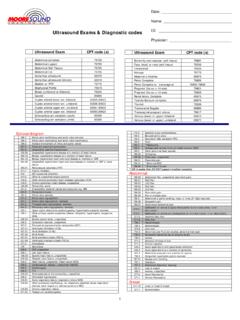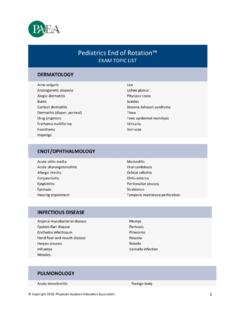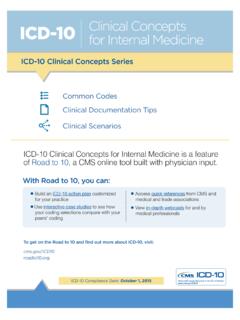Transcription of Prescribing Guidelines for Specialist Infant Formula Feeds
1 Prescribing Guidelines for Specialist Infant Formula Feeds Midlands and Lancashire CSU. Contributors to the document: Carol Pinder, Lancashire Teaching Hospitals NHS Foundation Trust (Original version of the document was contributed to by Julie Lonsdale, Midlands and Lancashire CSU and Melanie Preston, Blackpool CCG). December 2017. 1. (Review date December 2020). VERSION CONTROL. Version Number Date Amendments made 1 October 2013. 2 October Amended to be clearer around when Formula Feeds are 2014 okay to be prescribed on FP10. Amendments to the section on pre-term and low weight infants to allow Prescribing of PDF in some instances.
2 Corrections to say lactose free. Addition of other Formula brands. Nov 2014 Removal of LIFIB as contributors 3 December Guideline updated to reflect new MAP guideline. More 2017 information to support Prescribing added. January Nutramigen LGG 1 and 2 removed from the table in 2018 section as reconstitution instructions for these products not consistent with WHO recommendations for the preparation of Formula Feeds . Contents VERSION CONTROL .. 2. 1. INTRODUCTION .. 4. Exclusion criteria .. 4. Background .. 4. Guideline objective .. 5. 2. COW'S MILK PROTEIN ALLERGY .. 5. key messages .. 5. 3. DIAGNOSIS of CMA.
3 6. 4. A guide to Infant milk Formula choice for the management of CMA .. 8. Extensively Hydrolysed Infant Formula (EHF) .. 8. Amino Acid formulas (AAF) .. 8. Practical information on the management of CMA .. 9. 5. Re-challenging with milk and dairy products .. 9. Recommendations for challenging .. 9. 6. LACTOSE INTOLERANCE .. 10. 2. Key 10. Management of lactose intolerance .. 10. 7. Prescribing 11. Quantities to prescribe: .. 11. Prescription 11. Review and discontinuation of Specialist formulas .. 11. 8. OTHER Specialist Infant Formula .. 12. 9. REFERENCES .. 14. 10. ACKNOWLEDGEMENTS .. 14.
4 3. 1. INTRODUCTION. The purpose of this guidance is to outline recommendations for the Prescribing of Specialist Infant Formula milk within primary care in Lancashire. Lancashire promotes breastfeeding as the best form of nutrition for infants and this should be promoted, supported and protected wherever possible. Most of the Infant formulas prescribed in primary care are those to treat cow's milk protein allergy (CMA) therefore this document focuses on these Infant milks. There is a separate summary table in section 8 for other Specialist Infant milks. Exclusion criteria Secondary and tertiary care will continue to lead on the Prescribing of other Specialist Infant formulas for the following groups of patients.
5 These are outside the scope of this guideline: Preterm and low birth weight infants who may also require iron and vitamin supplementation Disease specific conditions inherited disorders of metabolism, renal disease, liver disease, cardiac disease, cystic fibrosis, oncology Complex / multiple food allergies and intolerance Faltering growth Complex medical cases infants requiring enteral tube feeding or the ketogenic diet All such Prescribing should be initiated by secondary care. Once stabilised the GP will be informed (and given clear instructions on the indication, goals and length of treatment, as required) and should take over the Prescribing .
6 The letter from secondary care should include details of prescriptions needed, all planned monitoring and follow up intended and guidance for the GP on when the Formula should be stopped. Background Cows' milk protein allergy is an immune-mediated allergic response to the proteins in milk. It can be immediate in onset following consumption, referred to as IgE mediated or a non-IgE mediated reaction when the presentation is delayed by hours or even days following exposure. Food allergy should not be confused with food intolerance, which is a non-immunological reaction that can be caused by enzyme deficiencies, pharmacological agents and naturally occurring substances.
7 Lactose intolerance occurs when there is reduced or absence of the enzyme lactase. Lactase is present in the lining of the small intestine. Low levels of this enzyme prevent the effective digestion of lactose and results in loose acidic stools. The undigested lactose ferments in the colon to produce gas and mild acid that causes discomfort and flatulence. 4. Symptoms presenting in infants with feeding difficulties are often non-specific and conditions can overlap. The majority of infants presenting with restlessness, colic and crying do not have CMA. Parents of an Infant should be offered reassurance and advice on managing common and natural problems like colic, constipation, reflux, lactose intolerance or overload.
8 CMA occurs in less than 8% of young infants, however between 5% and 15% of infants present with symptoms suggestive of CMA. Most infants with CMA develop symptoms before 6 months of age, and often within one week of introduction of a whole cow's milk protein Infant Formula . Approximately of exclusively breastfed infants present with CMA symptoms which are usually mild to moderate. If symptoms of CMA occur parents should be advised to continue breastfeeding and follow the advice detailed in the algorithms below. Allergy focused history taking, considering the severity and time of onset of symptoms, the source and quantity of the cow's milk ingested, along with any family history of atopy is important.
9 This guidance covers all infants; including those who breastfeed, those who are Formula fed or those who do a combination of both. Specialist milks should only be considered when there is truly a clinical need after thorough assessment. Guideline objective The objective of this guidance is to: Aid diagnosis and improve rapid access to Specialist Infant Formula where needed, minimising distress of the baby and anxiety to the parents/carers. Provide guidance on the nature, Prescribing and cost-effective supply of milk substitutes for babies in primary care. Provide advice on suitable quantities for Prescribing , duration of supply and guidance on stopping Prescribing .
10 Maintaining awareness that breast milk is considered best for babies and not initiating a change from breast to Formula milk if the mother is happy to continue breast feeding the Infant . This guidance should be used in conjunction with NICE Clinical Guideline 116 Food allergy in under 19's: assessment and diagnosis. NICE Clinical Knowledge summaries Cow's milk protein allergy in children (June 2015). 2. COW'S MILK PROTEIN ALLERGY. key messages 1. Breastfeeding is the best form of nutrition for infants and this should be promoted, supported and protected wherever possible 2. All infants with suspected IgE-mediated allergy should be referred to a dietitian /paediatric consultant for Specialist advice.











